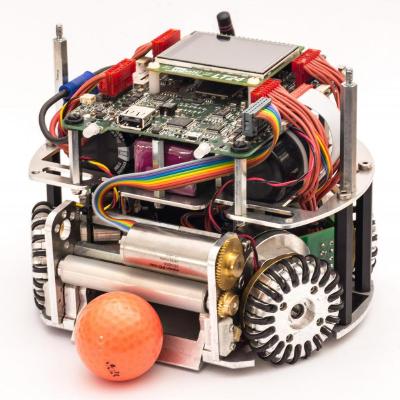In 2008, we will have a challenge setup similar to 2007. There will be two challenges to compare technical abilities needed for successfully playing robot soccer. Both are designed to be scalable, i.e. every team can participate almost without much special preparation. Of course, teams who spend extra time on preparing the challenge will probably benefit from their work.
Challenge 1 – Shooting and Passing
Put up to three robots on the field and score as many goals as possible within 120 seconds. Points are awarded as follows:
- 1 Point: Scoring a goal after only one robot has touched the ball
- 2 Points: Scoring a goal after two robots have touched the ball (i.e. after a pass)
- 3 Points: Scoring a goal after the ball has been touched at least three times by alternating robots (i.e. after at least two passes)
The rules for this challenge:
- To start, all robots must be placed within 1m from the own goal line.
- Opponent robots will be placed on the field as obstacles.
- A ball will be placed near one of the corners at the own side of the field.
- A goal can be scored only when the kicking robot is in the opponent’s half.
- Once a goal is scored or the ball has left the field, it will be placed again near one of the corners at the own side of the field.
Challenge 2 – Navigation
Two sets of obstacles (see attached sketch) are placed at each side of the field. One robot starts at the center of the field and must drive from one penalty mark of the field to the other as many times as possible within 120s. Every lap (from one set of obstacles to the other and back) counts as one point. Each time it has to drive through the gap between two obstacles. If it touches an obstacle, it gets a penalty of -1 points.
Additionally, teams are allowed to use up to three robots in parallel and sum up their laps. If two robots touch each other, the penalty also applies (per touching event, not per robot, of course).
If a robot has driven at least one lap (independently of the number of collisions), the team’s minimum number of points will be 1.
The red line indicates an example trajectory of a robot performing this challenge.
Challenges – Overall Ranking
The results from both challenges will be combined to get an overall technical challenge ranking.
To combine the challenge results, we will use the following formula:
Let BALL_SUM be the sum of all points that all teams received in the ball challenge and BALL_TEAM the number of points a single team received. Assume the same for the navigation challenge (NAV_*).
Then TOTAL_TEAM = BALL_TEAM / BALL_SUM + NAV_TEAM / NAV_SUM
